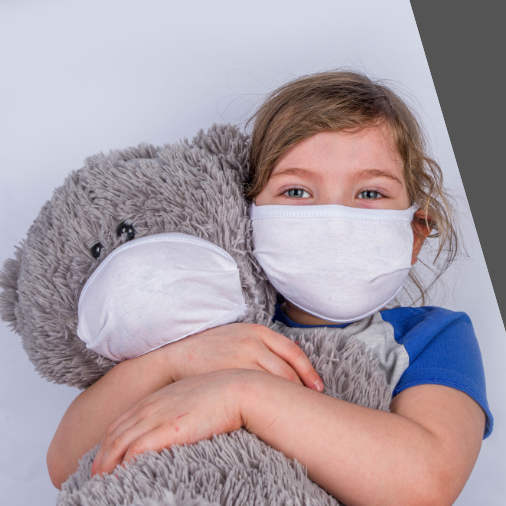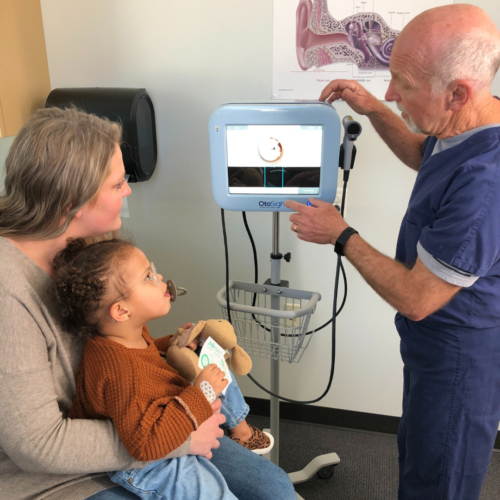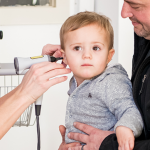Phone
866-411-EARS
Address
PhotoniCare Inc.
2800 Meridian Parkway, Suite 175
Durham, NC 27713

The COVID-19 pandemic has created numerous challenges for parents. Navigating shelter-in-place guidelines while keeping children happy, occupied, and healthy is no small feat. While initially research suggested that children were not as severely impacted by the novel Coronavirus, later cases have raised concerns about more severe effects than previously thought, such as Multisystem Inflammatory Syndrome in Children (MIS-C).
While COVID-19 may present a lower risk to children than adults, kids could still transmit this highly contagious virus to at-risk individuals. The Centers for Disease Control and Prevention recommend the following guidelines to help protect children and the people they encounter:
The American Academy of Pediatrics notes that social distancing remains critical in helping slow the spread of this devastating virus, and distancing guidelines have radically changed when and how families venture out into public places. One of the many concerns parents face is balancing shelter-in-place guidelines with the need to take children to the pediatrician. Determining whether a doctor’s visit is warranted or even safe weighs on many parents’ minds. During the early stages of the virus, concerns over the national supply of Personal Protective Equipment (PPE), as well as the risk of contracting or transmitting the virus led people to avoid doctor and hospital visits. As every parent knows, however, regular pediatrician visits are critical for young children, and ear infections are one of the most common reasons for a trip to their doctor.
As we have noted in a previous post, ear infections (otitis media) are one of the most common health problems children will face, affecting 4 out of 5 by their third birthday (and 90% of kids during their childhood). The Mayo Clinic notes that children are more prone to ear infections because their immune systems are still developing, and also because of the size and shape of their Eustachian tubes (a structure that helps naturally drain the middle ear) as they grow. Swelling or blockage of these tubes can lead to pressure from fluid and/or mucous build-up in the middle ear, causing pain and also possibly impeding the child’s hearing until the infection clears up. Chronic ear infections can lead to more sustained hearing loss and possible speech delays as a result.
What are the signs my child might have an ear infection?
Symptoms can appear rapidly in the case of an ear infection. Children will often complain of ear pain (particularly when lying down), but the following behaviors may also indicate an infection:
Additional symptoms parents should monitor include:
If symptoms last more than 24 hours, you should contact your pediatrician.
What kinds of treatment will they need?
Most ear infections will clear up on their own, in which case the primary focus of treatment is pain relief. Ear infections have historically been a prime recipient of antibiotic over-prescription, however the current recommended approach in most cases is to observe symptoms for 48 to 72 hours before prescribing antibiotics, in order to minimize the risk of antibiotic resistance. Dr. Robert M. Jacobson, chair of the Mayo Clinic’s Department of Pediatric and Adolescent Medicine, notes that “The body’s immune system can usually resolve [ear infections]. More and more studies show that children treated or untreated are at the same place 10 days out. We are constantly amazed at how many ear infections resolve on their own.”
Parents are urged to contact their pediatrician if symptoms persist more than 24 hours, however. Even if antibiotics will not be prescribed, your pediatrician can confirm what symptoms parents should monitor and prescribe medication or recommend over-the-counter remedies to help manage symptoms while the child’s immune system does its job. If the symptoms do not improve, then antibiotics may be necessary, and for chronic ear infections, placing tubes in the ears to facilitate drainage of any middle ear fluid, relieving pressure build-up, and reduce the frequency of infections.
Is it safe to visit the pediatrician under COVID restrictions?
The American Academy of Pediatrics absolutely recommends calling your pediatrician when ear infection symptoms last longer than 24 hours or become severe (e.g. fluid leaking, fever). Across the country, doctors’ offices are taking extra precautions to prevent the transmission of COVID-19 and make your visit as safe as possible. To allow for social distancing, pediatricians have developed strategies to help keep symptomatic and asymptomatic patients apart, or to separate out higher risk patients, such as infants.
Calling ahead can help the office plan for your visit and space out appointments to maintain social distancing. A telehealth consultation may also be available, allowing parents to discuss symptoms by phone or video conferencing in order to determine next steps in treatment. Through a telehealth consultation, your pediatrician can gauge the severity of symptoms, lay out an appropriate action plan in case they worsen, and even provide prescriptions or recommendations for over-the-counter remedies.
If an in-person consultation is necessary in order to treat a more severe ear infection, wearing a mask is recommended for children age 2 and above, in order to minimize the risk of transmission. Even someone who is asymptomatic can be carrying the virus, and a mask greatly reduces the risk of transmission of the virus through respiratory droplets or spit. A mask becomes particularly critical when a safe distance of 6 feet cannot be maintained, such as during a routine ear check-up. If a child is scared about wearing a face mask, the American Academy of Pediatrics has compiled a list of suggestions to help children overcome their apprehension. Children who are immunocompromised, putting them at a higher risk if they do contract the virus, wearing an N95 mask is recommended.
Based on current understanding of the novel Coronavirus, the treatments for ear infections outlined above do not appear to pose any risks in combination with COVID-19. Earlier this year, while in the early stages of understanding the virus, there were concerns that ibuprofen would not interact well with the virus, both the World Health Organization and the American Academy of Pediatrics no longer advise against the use of ibuprofen as a pain reliever/fever reducer when the risk of COVID-19 infection is present.
COVID-19 has disrupted daily routines in a number of ways, however it is important for parents to note that there is no reason to avoid consulting your pediatrician when ear infection symptoms develop and persist. Monitoring the infection under the guidance of your doctor will help keep your children healthy and happy.

PhotoniCare sits down with Dr. Michael Novak, an Ear, Nose… Read More

This week on the #EnginEarGuys blog we talk about otolaryngology… Read More

For some children, ear infections seem unavoidable. With the cold… Read More